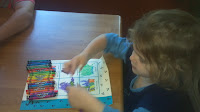I thought I would do a quick blog post that will give you a "Behind the Scenes" peek life!
I thought I would give you all a quick "Behind the Scenes" peek into our family life! Enjoy!
Summer was awesome! We wrapped the Summer up with a trip to the free Street Fair that was going on in town. The girls got to play games, get their faces painted, be an "Archaeologist" by using archaeology tools to dig through a tote with sand in it to find hidden Mayan "artifacts", make Mayan "masks" out of paper plates and paper scraps, and build a Mayan "tower" out of Legos. We all had a blast! :)
Sierra is six years old and in Second Grade this year. She started Preschool at (almost) three and has never slowed down. She is one of those children that just soak up everything they learn and never let it go! I wish my brain worked that good! :) She is doing a self-paced curriculum, Landmark's Freedom Baptist Curriculum, but she has been requiring a lot of attention these first few days... which is why we started with two weeks of half days first. See! Maybe I am smart after all! *Hee hee hee!*
Hannah is four. She started her K-4 curriculum Monday. She is soooo exited to finally be in school! She is just eating it all up! I am praying she stays this exited and teachable all year long! Hannah's curriculum is teacher-taught, as is most K-4 curriculums, but we are loving the one on one time! :)
 Rebekka is doing fine so far with being left out of the happenings. She usually plays well by herself, but I was kind of nervous, because she tends to find the most inopportune times to need someone to cuddle with. Have you ever noticed that with your children? Do yours play just fine when you are not busy, then sing a heart-breaking rendition of the "Jailhouse Blues" when you are busiest? Maybe not... but that is my Bekka! :) I love my cuddles and would not give them up for the world... even if I
Rebekka is doing fine so far with being left out of the happenings. She usually plays well by herself, but I was kind of nervous, because she tends to find the most inopportune times to need someone to cuddle with. Have you ever noticed that with your children? Do yours play just fine when you are not busy, then sing a heart-breaking rendition of the "Jailhouse Blues" when you are busiest? Maybe not... but that is my Bekka! :) I love my cuddles and would not give them up for the world... even if I  |
| Hannah wearing our new practice "boxing" gloves :) Forgive the fact that she has grape soda on her face! :) |
Sierra, Hannah, and I are starting Martial Arts Thursday. We are super exited, and cannot wait for our first class! We went and bought a used heavy bag (punching bag that stands on the floor) and gloves today so we can practice our kicks and strikes at home! I have been wanting to get back into Martial Arts since we moved from Florida, but we just have not had the time or the money. We are using the Martial Arts this year as an extra-curricular activity in the girls' homeschooling. :)
I have been staying busy with writing. On top of working on finishing up my next book, The Bond of Hearts, my new job through Elance.com keeps me hopping. In fact, last week, I wrote a total of twenty 500 word articles, two 1,000 word articles, and re-wrote a total of 20,000 words in articles (that just means that they provided me with the research, and I had to rewrite it so it was an article instead of a compilation of research)... I think that was all?... This week, I already finished up the one 1,000 word article and one 2,300 word article! Now I am starting a 300,000 word rewrite that is due Saturday!... *Whew!* I said all of that to say that I am going to try my best to stay on top of the blog and write in it every day, but if I skip a day here and there, I hope you will be forgiving!
God Bless! I hope you all have a wonderful school year, gets lots of cuddles, and smile a lot!
Until Next Time,
Author of The Fanatics




































